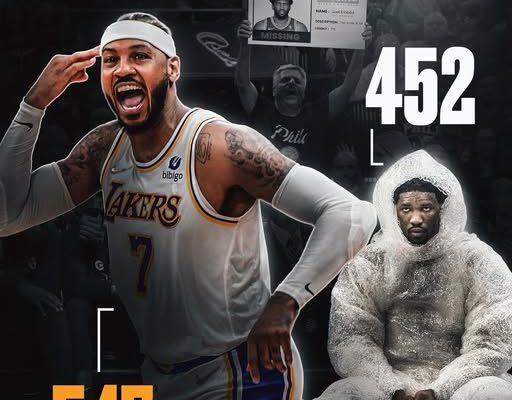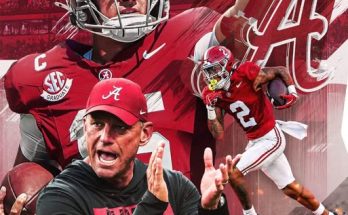Carmelo Anthony’s career has always been one of intrigue, legacy debates, and statistical quirks that continue to highlight both his longevity and his ability to withstand the grind of the NBA’s demanding schedule. When he officially retired from the league in 2023, closing out what had been a two-decade-long journey that began with his rookie season in 2003, many celebrated his prolific scoring ability, his ten All-Star appearances, and his status as one of the most gifted offensive forwards the game has ever seen. Yet one statistic that stands out as both fascinating and somewhat revealing about the way NBA careers unfold in the modern era is the fact that Carmelo Anthony has played more regular season games than Joel Embiid since 2014, despite the fact that Anthony has not been considered an elite force in the league for much of the past decade. This comparison sheds light on how durability, availability, and injuries have shaped the perception of two players from different eras of basketball.
Carmelo Anthony’s run in the NBA was defined in many ways by his ability to simply show up. He wasn’t always the most athletic player on the court, and as he aged, he had to reinvent himself to remain valuable to teams like the Portland Trail Blazers and Los Angeles Lakers, where he transitioned into more of a catch-and-shoot role. But one of his most underrated qualities was his ability to suit up and log minutes year after year. While some seasons late in his career saw him come off the bench, his availability made him a reliable presence for any roster he joined. After being drafted third overall in 2003 by the Denver Nuggets, Anthony would go on to play over 1,200 regular season games in his career, a figure that speaks volumes about both his consistency and his health. He was not immune to injuries, but compared to modern stars who struggle with load management and chronic health setbacks, Anthony represented a throwback of sorts—a player whose career was largely uninterrupted by long absences.
On the other hand, Joel Embiid’s career since being drafted third overall in 2014 by the Philadelphia 76ers has been one marked by sheer dominance when on the court, but also defined by long stretches of absence. Embiid sat out the first two seasons of his career entirely due to foot injuries, raising concerns about whether he would ever fulfill his immense potential. Once he did debut in the 2016–17 season, he immediately showcased why he was such a tantalizing prospect, combining size, footwork, shooting touch, and defensive instincts in a way that few big men in NBA history had ever done. But injuries continued to play a role, limiting his availability. Even during his prime MVP-caliber years, Embiid rarely played a full schedule, with the Sixers often erring on the side of caution to preserve his health for the postseason.
The comparison between Anthony and Embiid from 2014 onward illustrates the contrast between a durable veteran nearing the end of his career and a superstar entering his prime but unable to stay consistently on the floor. Carmelo, despite being in his 30s and no longer in his prime, still managed to rack up appearances with the Knicks, Thunder, Rockets, Blazers, and Lakers. In those years, he played through minor injuries, accepted reduced roles, and ultimately kept adding to his career games total. Embiid, meanwhile, missed his first two years entirely and has since battled a litany of issues, from knee and back concerns to hand injuries. As a result, his total regular season games played since his draft year pales in comparison to Anthony’s tally during the same span.
This comparison raises an important question in modern basketball: how do we evaluate greatness? For Embiid, the conversation is often about peak performance. When healthy, he is among the most dominant players in the NBA, having secured MVP honors, multiple All-NBA First Team selections, and recognition as one of the most unguardable players in the league. His per-game production is staggering, with averages often exceeding 30 points and double-digit rebounds while also serving as an elite rim protector. For Carmelo Anthony, greatness was defined differently. His peak years came earlier, when he was a perennial All-Star with the Nuggets and Knicks, leading the league in scoring in 2013 and serving as one of the most difficult isolation scorers in basketball. While his later years did not feature the same statistical dominance, his durability meant he was always adding to his resume. He may not have always been the best player on the court in the latter stages of his career, but his ability to be present and available is itself a form of value that should not be overlooked.
The Embiid–Anthony games played comparison is also reflective of the evolving conversation around player management in the NBA. During Anthony’s prime, there was no culture of load management. Stars were expected to play in most games unless they were injured. Teams did not routinely rest their stars for the purpose of maintaining long-term health or for strategic seeding advantages. Anthony’s era valued endurance and the ability to grind through an 82-game season. In contrast, Embiid has played in a league where load management and medical caution have become integral to player usage. Teams now operate with the understanding that stars are more valuable in the playoffs than in December regular season games. As a result, players like Embiid sit out back-to-backs, are carefully monitored for minutes, and are often kept out of games if there is even a slight risk of aggravating an injury.
This shift is important to contextualize when discussing Embiid’s relative lack of regular season games played. It isn’t simply a matter of him being injury-prone, though his health history is undeniable. It is also a function of the way the modern NBA prioritizes health and postseason performance. For Philadelphia, the goal has always been to have Embiid healthy for the playoffs, even if that means sacrificing regular season appearances. This reality makes it possible for someone like Carmelo, long past his peak, to have played more games over that period simply because his teams had fewer reasons to manage his workload.



